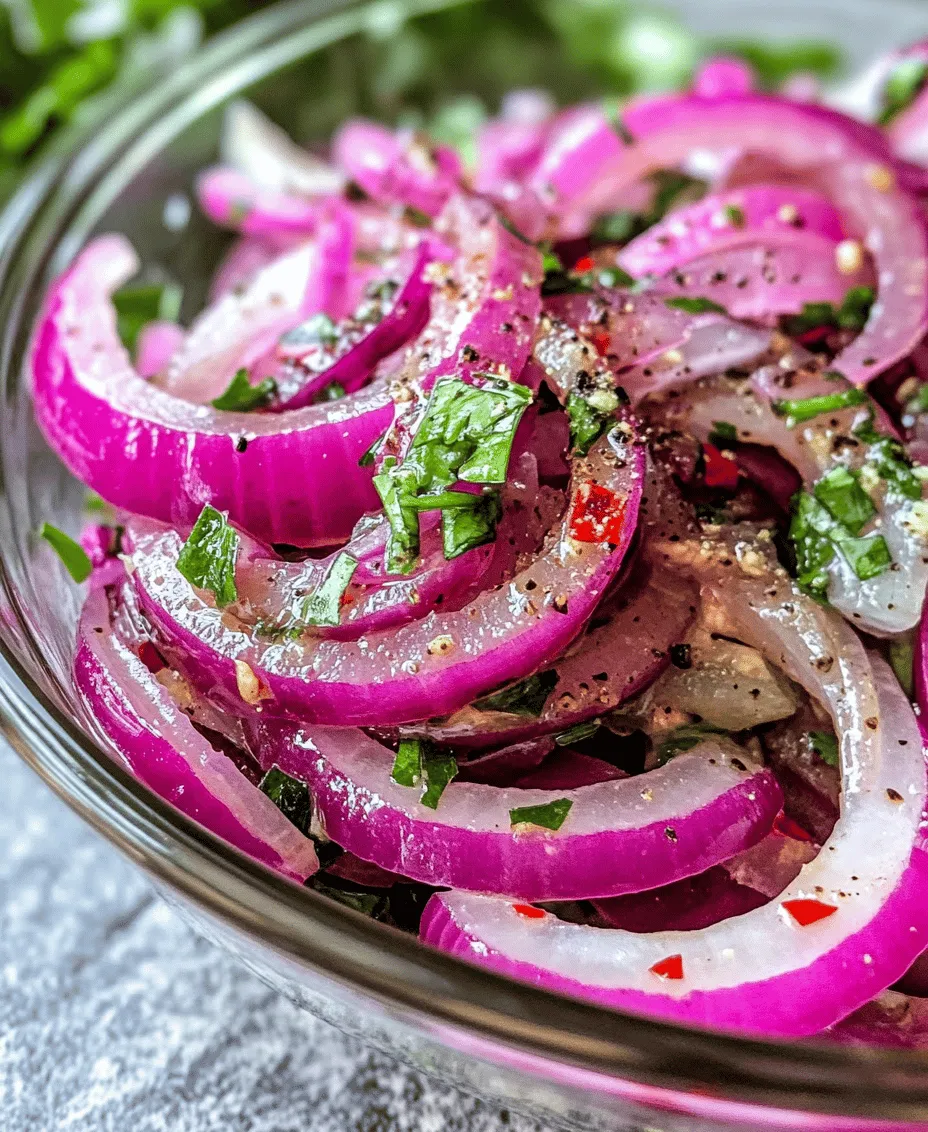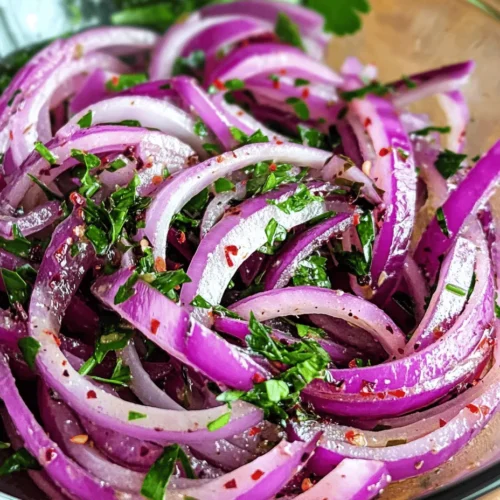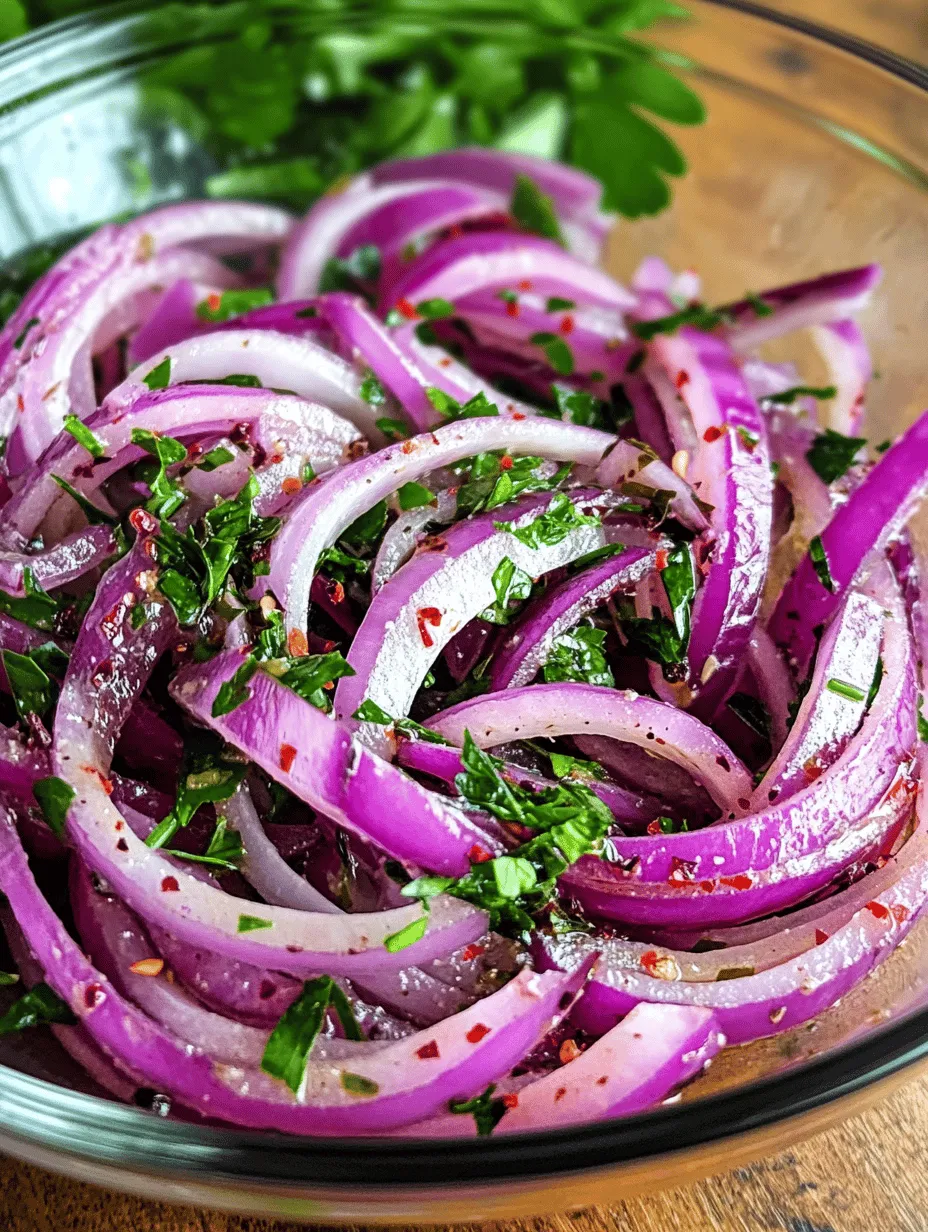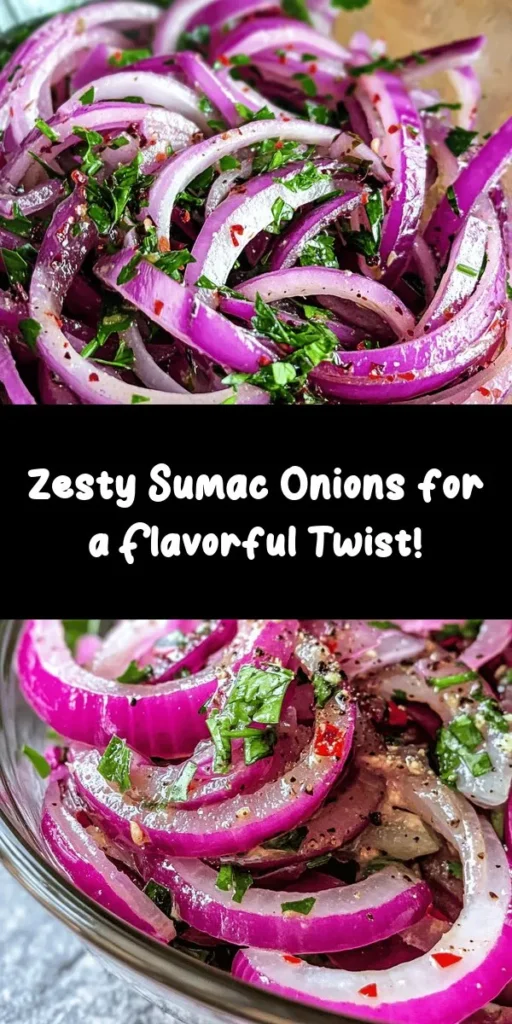Introduction
In the world of culinary delights, few ingredients can elevate a dish quite like onions. These versatile bulbs have been staples in kitchens worldwide for centuries, cherished for their ability to enhance flavors and add depth to a variety of dishes. Among the myriad ways to prepare onions, the Zesty Sumac Onions recipe stands out, offering a bright, tangy twist that promises to awaken your palate. Infused with the unique flavor of sumac, this dish captures the essence of Middle Eastern cuisine, transforming humble onions into a vibrant condiment that can elevate salads, grilled meats, and sandwiches alike.
Sumac, a spice that hails from the Middle East, is made from the dried and ground berries of the sumac shrub. Its tart, lemony flavor profile adds a refreshing zing that pairs beautifully with the sweetness of red onions. Beyond its culinary uses, sumac is also lauded for its health benefits, including anti-inflammatory properties and a rich antioxidant profile. When combined with the right ingredients, such as high-quality olive oil and fresh lemon juice, Zesty Sumac Onions become a delightful blend of taste and nutrition.
In this article, we will delve into the preparation of Zesty Sumac Onions, exploring the ingredients that contribute to its unique flavor, and providing a step-by-step guide to crafting this delicious dish.
Understanding the Ingredients
Detailed Description of Red Onions
Red onions are the stars of this recipe, bringing both color and flavor to the forefront. Their vibrant purple skin and white, crisp flesh make them visually appealing, while their sweet and mildly pungent taste sets them apart from their yellow and white counterparts. Red onions are particularly versatile; they can be eaten raw in salads, pickled, grilled, or roasted, making them a favorite among chefs and home cooks alike.
When it comes to nutritional value, red onions are a powerhouse. They are low in calories but rich in vitamins and minerals, including vitamin C, vitamin B6, and potassium. Additionally, red onions contain quercetin, a potent antioxidant known for its anti-inflammatory properties, which can promote heart health and strengthen the immune system. The natural sugars in red onions also contribute to their unique sweetness, especially when cooked.
Exploring Sumac
Next, we turn our attention to sumac, a spice that may be less familiar to some but is essential in Middle Eastern cooking. Sumac has a deep red hue and a tangy flavor reminiscent of lemon, making it an ideal seasoning for dishes that require a touch of acidity. The spice is made from drying the berries of the sumac shrub, which grows wild in the Mediterranean and parts of the Middle East.
Traditionally, sumac has been used as a souring agent, often sprinkled over salads, grilled meats, and rice dishes. Its versatility means it can enhance flavors without overpowering them, allowing the natural essence of the primary ingredients to shine through. Beyond its culinary uses, sumac offers a range of health benefits. It is rich in antioxidants and has been linked to reducing inflammation, improving heart health, and aiding in digestion. Incorporating sumac into your cooking not only enhances flavor but also adds a healthy twist to your meals.
The Role of Olive Oil and Lemon Juice
In the Zesty Sumac Onions recipe, olive oil and lemon juice play crucial roles in creating a harmonious blend of flavors. Using high-quality olive oil is essential; it not only contributes a rich, fruity flavor but also offers a wealth of health benefits. Extra virgin olive oil is packed with antioxidants and healthy fats, which can help lower bad cholesterol levels and reduce the risk of heart disease. The oil also adds a silky texture to the dish, ensuring that the onions and spices adhere well together.
Lemon juice is another key ingredient that brings brightness and acidity to the Zesty Sumac Onions. The acidity of lemon juice is vital for balancing flavors, especially when paired with the sweetness of the onions and the tartness of the sumac. Acidity not only enhances the overall taste of the dish but also helps to tenderize the onions, making them more palatable and enjoyable.
Understanding Optional Ingredients
While the core ingredients of red onions, sumac, olive oil, and lemon juice create a fantastic base for this dish, optional ingredients can introduce additional layers of flavor. One such ingredient is red pepper flakes. Adding a pinch of red pepper flakes can introduce a subtle heat that complements the tanginess of the sumac and the sweetness of the onions. This small but impactful addition can elevate the dish from a simple condiment to a standout side.
Another optional ingredient to consider is fresh parsley. Chopped parsley not only adds a pop of color but also contributes a fresh, herbal flavor that brightens the overall dish. The garnish enhances the presentation and provides a contrast to the deep hues of the red onions and the rich olive oil. Incorporating fresh herbs into your cooking is an excellent way to boost both flavor and nutrition, as herbs are often packed with vitamins and antioxidants.
Step-by-Step Guide to Preparing Zesty Sumac Onions
Now that we’ve explored the vibrant ingredients that make up Zesty Sumac Onions, it’s time to dive into the preparation process. Follow these steps to create your own batch of this delicious and tangy condiment.
Preparing the Onions
To begin, selecting the right onions is crucial. Look for firm red onions with smooth skin and no blemishes. Freshness is key to achieving the best flavor and texture. Once you’ve chosen your onions, it’s time to prepare them for slicing.
Techniques for Slicing Red Onions
Start by peeling the outer skin of the red onions. To make slicing easier, consider cutting off both ends of the onion to create a stable base. Place the onion flat side down on the cutting board, and carefully slice it in half from top to bottom. With the cut side facing down, slice each half into thin crescent-shaped pieces. Aim for slices that are about 1/8 inch thick; this thickness allows the onions to absorb the flavors of the dressing while maintaining a satisfying crunch.
The Process of Salting and Its Effect on Texture
Once the onions are sliced, transfer them to a mixing bowl and sprinkle them lightly with salt. Salting the onions serves a dual purpose: it enhances their natural flavor and draws out excess moisture, resulting in a crisper texture. Allow the salted onions to sit for about 10-15 minutes. During this time, you’ll notice the onions will soften slightly and release some of their liquid.
After the resting period, give the onions a gentle rinse under cold water to remove excess salt. Pat them dry with a clean kitchen towel or paper towels. This step is essential to prevent the dish from becoming overly salty and to ensure that the flavors of the dressing shine through.
Creating the Dressing
With the onions prepared, it’s time to create the dressing that will tie all the flavors together. In a separate bowl, combine the following ingredients:
– Sumac: Start with about 2 tablespoons of sumac, adjusting to your taste preference.
– Olive Oil: Add 3-4 tablespoons of high-quality extra virgin olive oil for richness.
– Lemon Juice: Squeeze in the juice of one fresh lemon, approximately 2-3 tablespoons.
Whisk these ingredients together until well combined. The vibrant red of the sumac will blend with the golden hue of the olive oil, creating a visually appealing dressing. Taste the dressing and adjust the seasoning if necessary, perhaps adding more sumac for tanginess or a pinch of salt to enhance the overall flavor.
Once the dressing is ready, add the prepared onions to the bowl and toss gently to coat. Ensure that every slice is evenly coated with the zesty mixture, allowing the flavors to meld together. For an added kick, this is the stage where you can sprinkle in red pepper flakes, if desired.
By following these steps, you’ll be on your way to creating a delicious batch of Zesty Sumac Onions. This dish is perfect for serving alongside grilled meats, mixing into salads, or simply enjoying as a tangy snack. The combination of the sweet and slightly spicy onions, the tangy sumac, and the richness of the olive oil creates a unique flavor experience that is sure to impress. Stay tuned for the next part, where we will delve deeper into serving suggestions and variations for this delightful condiment.

Importance of Emulsifying Ingredients for Flavor Distribution
When creating the dressing for your Zesty Sumac Onions, emulsifying the ingredients is crucial for achieving a harmonious blend of flavors. An emulsion occurs when two liquids that typically do not mix—like oil and vinegar—are combined into a stable mixture. This process not only enhances the texture of your dressing but also ensures that every bite of onion is infused with that delicious zesty flavor.
To achieve a well-emulsified dressing, start by whisking together your vinegar and sumac in a bowl. Gradually add the olive oil while whisking continuously until the mixture thickens and becomes creamy. This technique guarantees that the sumac, a tangy spice with lemony undertones, coats the onions evenly, elevating their taste and making them irresistible.
Tips for Adjusting the Dressing to Personal Taste
While the basic dressing recipe is a fantastic starting point, feel free to adjust it according to your personal preferences. Here are some tips for customizing your dressing:
1. Change the Vinegar: Experiment with different types of vinegar, such as red wine vinegar or apple cider vinegar, to find a flavor that resonates with your palate.
2. Add Sweetness: If you prefer a sweeter dressing, consider adding a touch of honey or maple syrup. This contrast will balance the acidity of the vinegar and the tanginess of the sumac.
3. Incorporate Fresh Herbs: Fresh herbs like parsley, mint, or dill can add an aromatic freshness to the dressing. Chop them finely and mix them in for an herby kick.
4. Adjust the Sumac: For a more pronounced tang, increase the amount of sumac. Conversely, if you’re new to this spice, start with a smaller amount and build up gradually.
5. Spice It Up: A pinch of chili flakes or a dash of hot sauce can introduce a delightful heat to the dressing, enhancing the overall flavor profile.
Marination Process
Once you’ve prepared your Zesty Sumac Onions by slicing the onions and making the dressing, the next step is marination. This process is key to enhancing the flavor and ensuring the onions absorb the tangy dressing fully.
1. Combine: In a mixing bowl, toss the sliced onions with the dressing until they are well coated. Ensure every piece is submerged in the flavorful mixture.
2. Cover and Refrigerate: Transfer the onions and dressing into a jar or an airtight container. Seal it tightly and place it in the refrigerator.
3. Marinate: Let the onions marinate for at least 30 minutes. For the best results, aim for 2 to 4 hours. This extended marination allows the flavors to meld and the acidity of the dressing to soften the onions, making them sweeter and more palatable.
Why Marinating is Crucial for Flavor Infusion
Marinating is much more than just letting ingredients sit together; it is a transformative process that enhances flavors and textures. Here’s why marination is crucial for your Zesty Sumac Onions:
– Flavor Penetration: The acids in the dressing penetrate the onion layers, allowing the flavors to infuse deeply rather than just coating the surface.
– Texture Improvement: The marination process softens the raw onions, making them less pungent and more enjoyable to eat. This is particularly important for those who may find raw onions too harsh.
– Color Enhancement: As the onions soak up the dressing, they take on a beautiful pink hue, making them visually appealing as well.
Suggested Marination Times for Optimal Taste
For optimal flavor infusion and texture, here are some suggested marination times:
– Minimum: 30 minutes – This is sufficient for a quick infusion of flavors if you’re in a hurry.
– Ideal: 2 to 4 hours – This time frame allows the onions to soften and absorb the dressing fully.
– Maximum: Up to 24 hours – You can marinate the onions overnight for an intense flavor. Just be cautious, as prolonged marination may lead to overly soft onions.
Serving Suggestions
Zesty Sumac Onions are incredibly versatile and can be used in a variety of dishes. Here are some fantastic serving suggestions to help you incorporate this flavorful condiment into your meals:
Pairing Ideas
1. Grilled Meats: These zesty onions make an excellent topping for grilled chicken, lamb, or beef. The tangy flavor complements the smoky char from the grill beautifully.
2. Salads: Toss Zesty Sumac Onions into green salads for an added burst of flavor and texture. They pair wonderfully with ingredients like feta cheese, cucumbers, and tomatoes.
3. Mezze Platter: Serve the onions as part of a mezze platter alongside hummus, baba ghanoush, olives, and pita bread. This traditional Middle Eastern serving style allows for a delightful variety of tastes and textures.
4. Mediterranean Dishes: Incorporate these onions into Mediterranean dishes like tabbouleh or grain bowls. They add a refreshing zing that brightens the entire dish.
5. Fusion Recipes: Get creative by using Zesty Sumac Onions in tacos, burritos, or even on a burger. Their unique flavor can elevate many classic dishes.
Nutritional Analysis and Health Benefits
Understanding the nutritional content of Zesty Sumac Onions can help you appreciate the benefits of this dish. Here’s a brief overview of what each serving contributes:
– Calories: Approximately 50 calories per serving (1/2 cup).
– Carbohydrates: 10 grams, primarily from the onions.
– Fiber: 2 grams, aiding digestion.
– Vitamin C: Onions are a good source, promoting a healthy immune system.
– Antioxidants: Both onions and sumac are rich in antioxidants, helping combat oxidative stress in the body.
Health Benefits of Onions and Sumac
– Antioxidant Properties: Onions contain quercetin, a powerful antioxidant that has anti-inflammatory properties and may help reduce the risk of chronic diseases.
– Digestive Benefits: Onions are a good source of fiber, which promotes healthy digestion. Sumac also has digestive benefits, traditionally used in Middle Eastern cuisine to aid stomach health.
– Balanced Diet: Zesty Sumac Onions can fit seamlessly into a balanced diet. They are low in calories, nutrient-dense, and can add flavor without the need for additional fats or sugars.
Conclusion
Zesty Sumac Onions offer a delicious blend of flavors that can elevate a variety of dishes. Their versatility as a topping for grilled meats, an addition to salads, or part of a mezze platter makes them a valuable addition to any culinary repertoire. Not only do they deliver a delightful taste experience, but they also come packed with health benefits from their main ingredients, onions and sumac.
As you explore the many uses and adaptations of Zesty Sumac Onions, you’ll discover the joy of cooking with fresh ingredients and spices. Whether you stick to traditional pairings or venture into fusion cuisine, this recipe invites creativity and experimentation in your kitchen. Embrace the flavors, enjoy the process, and savor every bite!



